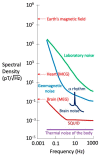Biomagnetism: The First Sixty Years
- PMID: 37177427
- PMCID: PMC10181075
- DOI: 10.3390/s23094218
Biomagnetism: The First Sixty Years
Abstract
Biomagnetism is the measurement of the weak magnetic fields produced by nerves and muscle. The magnetic field of the heart-the magnetocardiogram (MCG)-is the largest biomagnetic signal generated by the body and was the first measured. Magnetic fields have been detected from isolated tissue, such as a peripheral nerve or cardiac muscle, and these studies have provided insights into the fundamental properties of biomagnetism. The magnetic field of the brain-the magnetoencephalogram (MEG)-has generated much interest and has potential clinical applications to epilepsy, migraine, and psychiatric disorders. The biomagnetic inverse problem, calculating the electrical sources inside the brain from magnetic field recordings made outside the head, is difficult, but several techniques have been introduced to solve it. Traditionally, biomagnetic fields are recorded using superconducting quantum interference device (SQUID) magnetometers, but recently, new sensors have been developed that allow magnetic measurements without the cryogenic technology required for SQUIDs.
Keywords: SQUID magnetometer; biomagnetism; inverse problem; magnetocardiogram; magnetoencephalogram; optically pumped magnetometer.
Conflict of interest statement
The author declares no conflict of interest.
Figures








References
-
- Hämäläinen M., Hari R., Ilmoniemi R.J., Knuutila J., Lounasmaa O.V. Magnetoencephalography: Theory, instrumentation, and applications to noninvasive studies of the working human brain. Rev. Mod. Phys. 1993;65:413–497. doi: 10.1103/RevModPhys.65.413. - DOI
-
- Baule G., McFee R. Theory of magnetic detection of the heart’s electrical activity. J. Appl. Phys. 1965;36:2066–2077. doi: 10.1063/1.1714404. - DOI
-
- Zimmerman J.E. SQUID instruments and shielding for low-level magnetic measurements. J. Appl. Phys. 1977;48:702–710. doi: 10.1063/1.323659. - DOI
Publication types
MeSH terms
LinkOut - more resources
Full Text Sources

